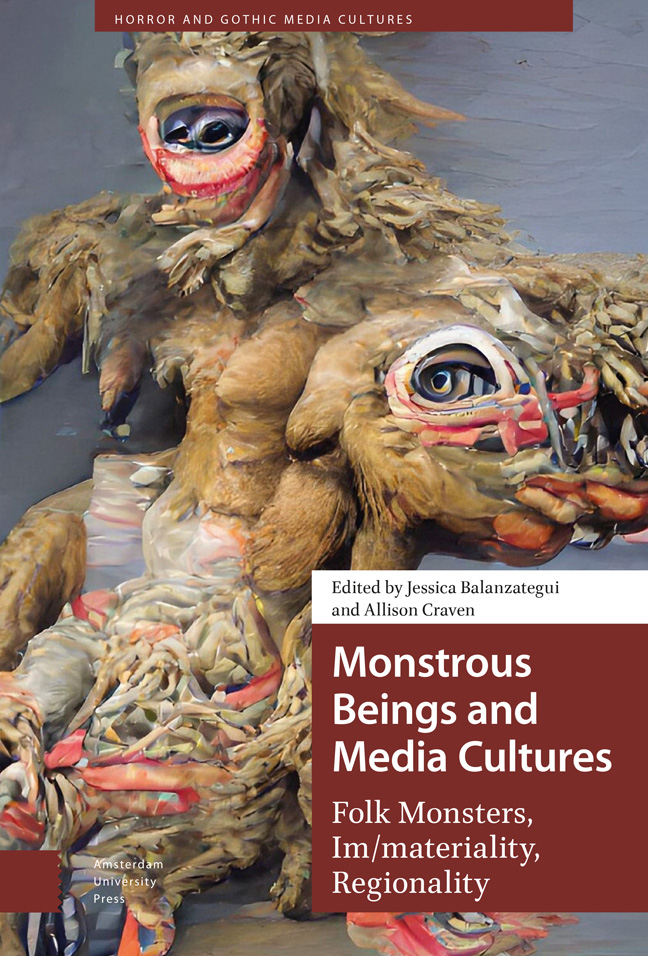Book contents
- Frontmatter
- Contents
- List of Figures
- Acknowledgements
- Introduction: Folk Monsters and Monstrous Media: The Im/materialties, Modalities, and Regionalities of Being(s) Monstrous
- 1 The Momo Challenge as Urban Legend: Child and Adult Digital Cultures and the Global Mediated Unconscious
- 2 “Every Imaginable Invention of the Devil”: Summoning the Monstrous in Eurocentric Conceptions of Voodoo
- 3 The Forest and the Trees: The “Woods” as Intersection between Documentary, Fairy Tale, and Internet Legend in Beware the Slenderman
- 4 Mark Duplass as Mumblegore Serial Killer: Fictional Vernacular Filmmaking in the Creep Series
- 5 Monsters in the Forest: “Little Red Riding Hood” Crimes and Ecologies of the Real and Fantastic
- 6 A Mother's Milk: Motherhood, Trauma, and Monstrous Children in Folk Horror
- 7 Documenting the Unheard: The Poetics of Listening and Empathy in The Family
- 8 Reimagining the Pontianak Myth in Malaysian Folk Horror: Flexible Tradition, Cinema, and Cultural Memory
- 9 An Uncommon Ancestor: Monstrous Emanations and Australian Tales of the Bunyip
- 10 The Folk Horror “Feeling”: Monstrous Modalities and the Critical Occult
- Works Cited
- Mediagraphy
- Index
4 - Mark Duplass as Mumblegore Serial Killer: Fictional Vernacular Filmmaking in the Creep Series
Published online by Cambridge University Press: 17 February 2024
- Frontmatter
- Contents
- List of Figures
- Acknowledgements
- Introduction: Folk Monsters and Monstrous Media: The Im/materialties, Modalities, and Regionalities of Being(s) Monstrous
- 1 The Momo Challenge as Urban Legend: Child and Adult Digital Cultures and the Global Mediated Unconscious
- 2 “Every Imaginable Invention of the Devil”: Summoning the Monstrous in Eurocentric Conceptions of Voodoo
- 3 The Forest and the Trees: The “Woods” as Intersection between Documentary, Fairy Tale, and Internet Legend in Beware the Slenderman
- 4 Mark Duplass as Mumblegore Serial Killer: Fictional Vernacular Filmmaking in the Creep Series
- 5 Monsters in the Forest: “Little Red Riding Hood” Crimes and Ecologies of the Real and Fantastic
- 6 A Mother's Milk: Motherhood, Trauma, and Monstrous Children in Folk Horror
- 7 Documenting the Unheard: The Poetics of Listening and Empathy in The Family
- 8 Reimagining the Pontianak Myth in Malaysian Folk Horror: Flexible Tradition, Cinema, and Cultural Memory
- 9 An Uncommon Ancestor: Monstrous Emanations and Australian Tales of the Bunyip
- 10 The Folk Horror “Feeling”: Monstrous Modalities and the Critical Occult
- Works Cited
- Mediagraphy
- Index
Summary
Abstract
The Creep series comprises two US found footage horror films directed by Patrick Brice and produced by Duplass Brothers Productions as part of the “mumblegore” film movement. Mumblegore refers to horror films directed by or including the participation of filmmakers associated with the larger mumblecore indie drama movement. As a film movement and a sub-genre, mumblegore represents a distinct type of folkloresque fictional vernacular film. Both Creep (2014) and its sequel Creep 2 (2017) centre around Josef (played by indie film icon Mark Duplass), a prolific serial killer who preys on amateur filmmakers. The Creep series engages with a number of vernacular or “folk” filmmaking aesthetics, including those associated with “folk horror.” The Creep films feature and comment on vernacular film practices. As such, they can be considered “fictional vernacular films.”
Keywords: mumblegore, Mark Duplass, vernacular horror, found footage, folk horror, mumblecore
The Creep series comprises two US found footage horror films directed by Patrick Brice and produced by Duplass Brothers Productions as part of the “mumblegore” film movement. Both Creep (2014) and Creep 2 (2017) centre around Josef, a prolific serial killer who preys on amateur filmmakers. The Creep films do contain some genre elements associated with “folk horror” as defined by Adam Scovell (2017), including secluded, rural settings. However, I do not argue in this chapter that these films are fully aligned with these folk horror traditions. More significantly, the Creep series engages with “folk” filmmaking aesthetics. Both Josef and his victims are involved in the production of “vernacular films,” a folk style of filmmaking which Pauline Greenhill describes as being “produced by amateurs to record significant events in the lives of their families and communities” (2012, 484). Josef invites or employs his victims to document his life, but they are unaware that Josef is secretly filming them too and collects all this footage for his own personal archives, commemorating each victim he kills. Being fictional narratives, the Creep films themselves are not truly vernacular film but instead feature and comment on vernacular film practices. Adopting Greenhill's description of her own case studies, the Creep series is “at the cusp of folklore and film” (2012, 484).
- Type
- Chapter
- Information
- Monstrous Beings and Media CulturesFolk Monsters, Im/materiality, Regionality, pp. 103 - 120Publisher: Amsterdam University PressPrint publication year: 2023



